-
Out of stock
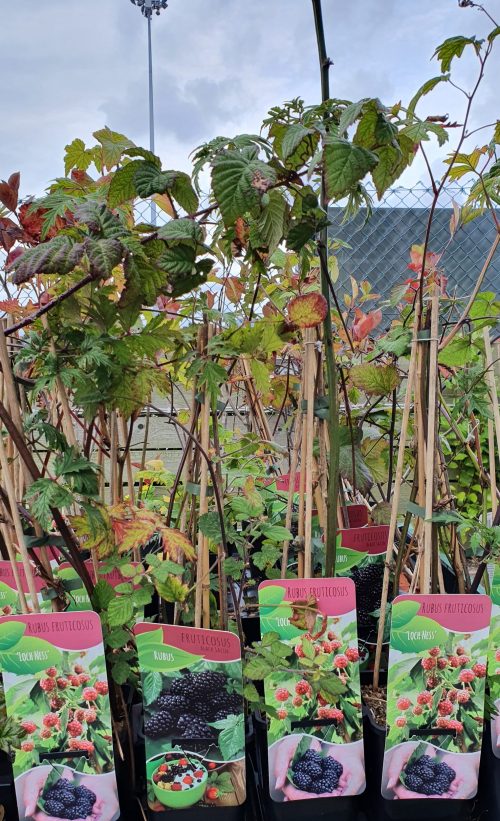
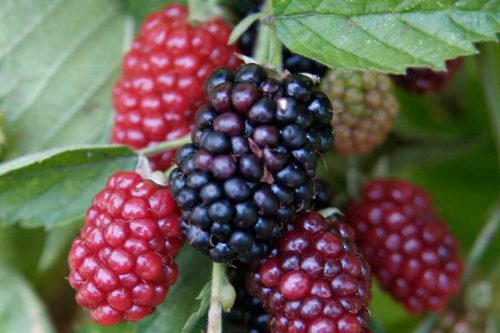 2.5m ht x 2.5m sp 2-5 years until maturity ‘Loch Ness’ is a moderate-sized bush with upright thornless canes, white flowers in summer followed by dark blackberries in late summer.
2.5m ht x 2.5m sp 2-5 years until maturity ‘Loch Ness’ is a moderate-sized bush with upright thornless canes, white flowers in summer followed by dark blackberries in late summer. -
Out of stock
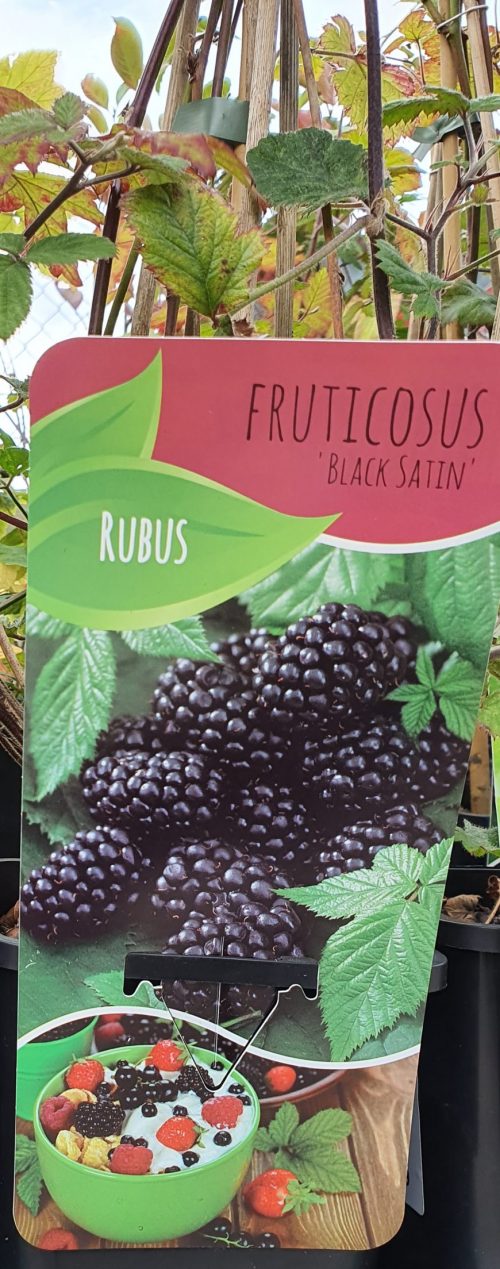
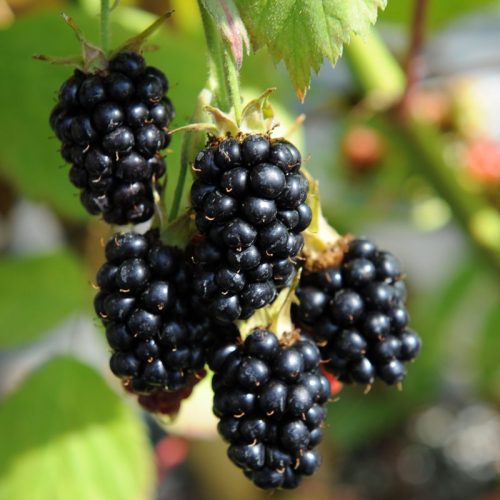 A thornless, American-bred blackberry, Rubus fruticosus Black Satin produces medium to large, rounded, black very juicy berries with a delicious, rather sharp flavour from late July, earlier than most thornless blackberries. Beautiful pale pink flowers and fruit are borne on two-year-old wood; yields are high and reliable. Blackberry Black Satin is a deciduous shrub with upright canes, to 10’/3m, which should be tied into post and wire supports or wires on a warm wall or fence to keep the plant from running rampant and make harvesting easier; cut down fruited canes and tie in new growth after the harvest. Good plant for pollinators. Site: Warm, sheltered, sunny site Soil: Any reasonable, well-drained soil, preferably neutral Position: Full sun Pick: From late July and through August Keep: Fruit does not keep, but freezes well Hardiness: Fully hardy Pollination: Self-fertile Uses: Eating fresh, cooking, preserving
A thornless, American-bred blackberry, Rubus fruticosus Black Satin produces medium to large, rounded, black very juicy berries with a delicious, rather sharp flavour from late July, earlier than most thornless blackberries. Beautiful pale pink flowers and fruit are borne on two-year-old wood; yields are high and reliable. Blackberry Black Satin is a deciduous shrub with upright canes, to 10’/3m, which should be tied into post and wire supports or wires on a warm wall or fence to keep the plant from running rampant and make harvesting easier; cut down fruited canes and tie in new growth after the harvest. Good plant for pollinators. Site: Warm, sheltered, sunny site Soil: Any reasonable, well-drained soil, preferably neutral Position: Full sun Pick: From late July and through August Keep: Fruit does not keep, but freezes well Hardiness: Fully hardy Pollination: Self-fertile Uses: Eating fresh, cooking, preserving -
Out of stock
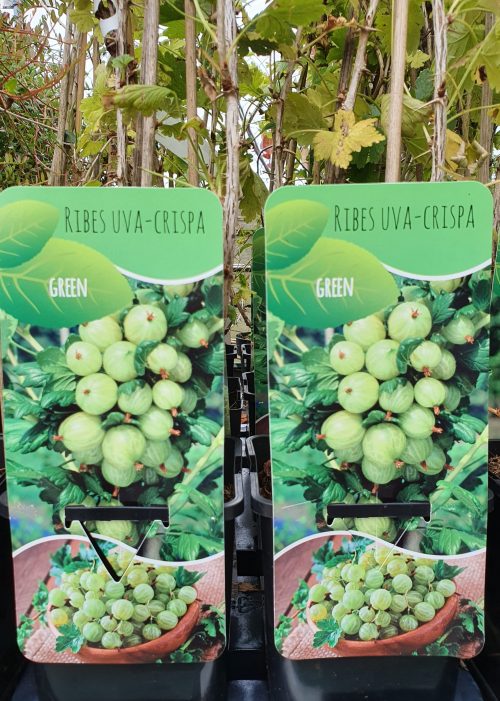
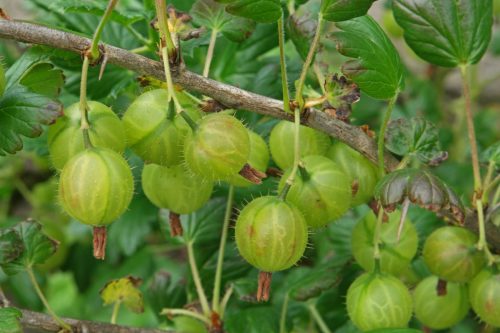
Gooseberries are a staple of the British cottage garden. They’re easy to grow and can thrive in many kinds of soil, as long as they’re grown in full sun. Grow them as compact bushes or train them against a wall. You can also grow gooseberry bushes in containers.Grow in fertile, well-drained soil in a sunny, sheltered site. If growing as a bush, prune gooseberries annually to maintain an open, bowl-shape, which makes picking easier. How to grow Ribes uva-crispa
-
Plant size
1.5m height
1.5m spread
-
Aspect
South facing, west facing
- Sun exposure: Full sun
- Hardiness: Hardy
- Soil type: Well drained / light / sandy
-
-
Out of stock
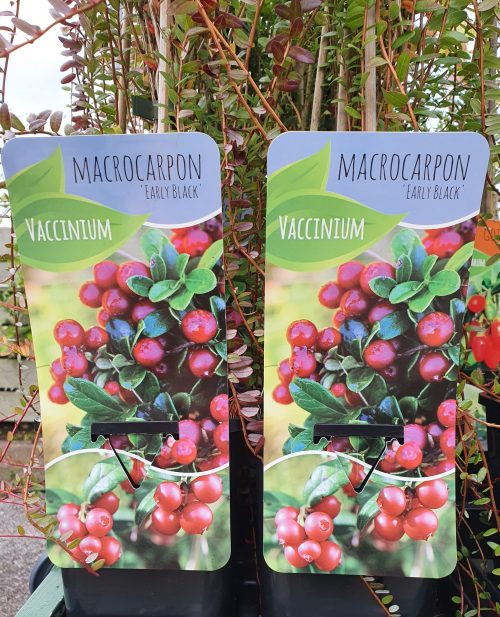
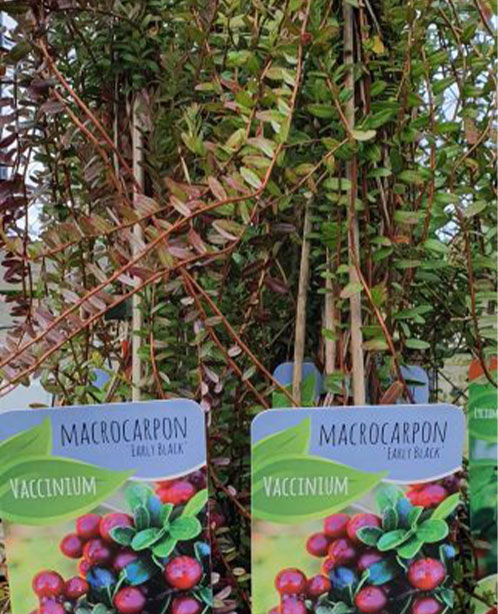 The fruits of 'Early Black' aren't actually black - starting off bright red they ripen to a deep purple-red that could easily be mistaken for black. But it certainly lives up to the 'Early in its name, cropping from late August - which makes it the earliest variety. High in Vitamin C, the fruits can be made into pies and puddings, crushed and made into juice, or made into Cranberry Jelly - perfect for the Christmas Turkey! Growing to a maximum of around 2 feet (60 cm) tall, this small evergreen bush does best in a full sun or a semi-shade position where it can be allowed to scramble as it wishes. Harvest from late August. Suitable for both open ground or container growing. For open ground planting plant 12" x 12" (30 x 30 cm) apart. Ericaceous, so will require soil or compost of an acidic nature. Self-fertile.
The fruits of 'Early Black' aren't actually black - starting off bright red they ripen to a deep purple-red that could easily be mistaken for black. But it certainly lives up to the 'Early in its name, cropping from late August - which makes it the earliest variety. High in Vitamin C, the fruits can be made into pies and puddings, crushed and made into juice, or made into Cranberry Jelly - perfect for the Christmas Turkey! Growing to a maximum of around 2 feet (60 cm) tall, this small evergreen bush does best in a full sun or a semi-shade position where it can be allowed to scramble as it wishes. Harvest from late August. Suitable for both open ground or container growing. For open ground planting plant 12" x 12" (30 x 30 cm) apart. Ericaceous, so will require soil or compost of an acidic nature. Self-fertile. -
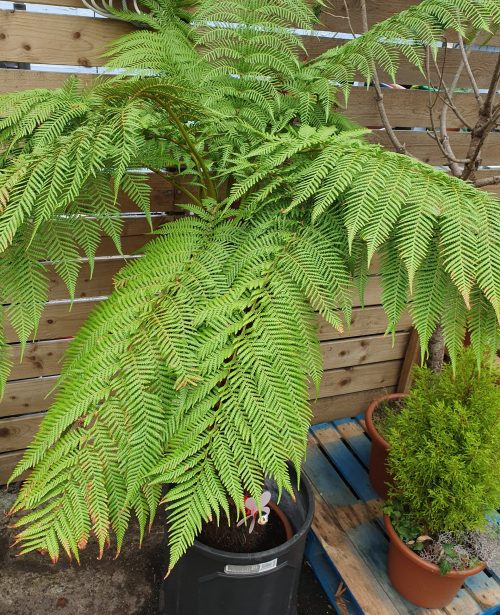
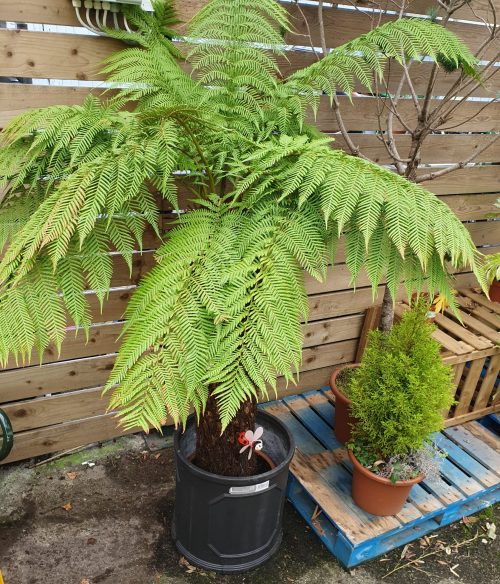 Native to coastal parts of Australia, Dicksonia antarctica is a magnificent, slow-growing, evergreen tree-fern (deciduous in colder areas) and one of the easiest to grow. The brown, fibrous ‘stem’ slowly grows taller, crowned by a rosette of beautiful, glossy, deep green fronds up to three metres long – a wonderfully architectural plant. Winter protection essential in all but the mildest areas – wrap the top of the ‘stem’ in fleece and protect the growing point in the crown with straw or similar insulation, and if pot-grown, bring inside or insulate the pot. Water the stem in hot weather; do not water the crown in winter. Site: Sheltered, sheltered coastal Soils: Moist but well-drained, acid to neutral soil Position: Partial shade or dappled shade Season of interest: Most of the year Hardiness: Frost-hardy Height to 13’ (4m) Spread to 13’ (4m)
Native to coastal parts of Australia, Dicksonia antarctica is a magnificent, slow-growing, evergreen tree-fern (deciduous in colder areas) and one of the easiest to grow. The brown, fibrous ‘stem’ slowly grows taller, crowned by a rosette of beautiful, glossy, deep green fronds up to three metres long – a wonderfully architectural plant. Winter protection essential in all but the mildest areas – wrap the top of the ‘stem’ in fleece and protect the growing point in the crown with straw or similar insulation, and if pot-grown, bring inside or insulate the pot. Water the stem in hot weather; do not water the crown in winter. Site: Sheltered, sheltered coastal Soils: Moist but well-drained, acid to neutral soil Position: Partial shade or dappled shade Season of interest: Most of the year Hardiness: Frost-hardy Height to 13’ (4m) Spread to 13’ (4m) -
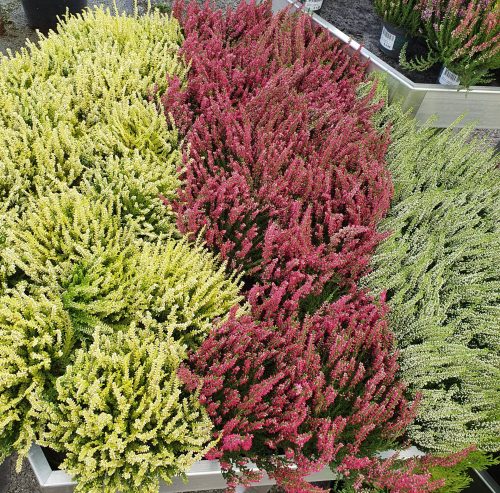
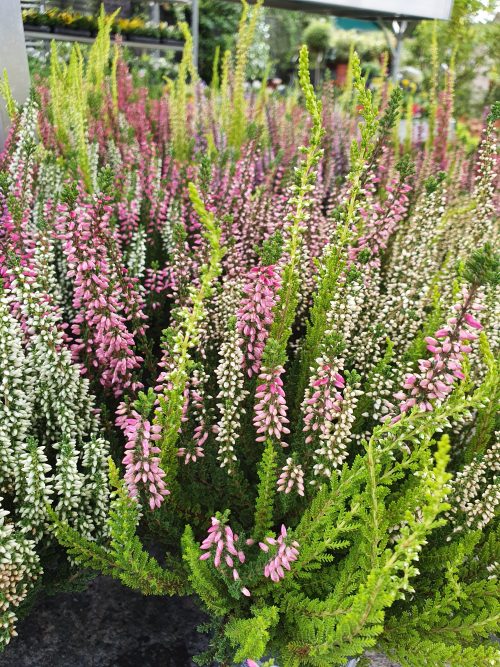 Calluna vulgaris, also known as common Scotch Heather is a low growing perennial shrub; it blooms with very long lasting, sweet smelling flowers in late summer that will attract many insects with their sweet nectar in late summer. Their dense spreading habit makes them perfect as a ground covering plant or for a charming display on your patio or balcony.
Calluna vulgaris, also known as common Scotch Heather is a low growing perennial shrub; it blooms with very long lasting, sweet smelling flowers in late summer that will attract many insects with their sweet nectar in late summer. Their dense spreading habit makes them perfect as a ground covering plant or for a charming display on your patio or balcony.- Fragrant
- Covers bare spots quickly
- Bee Friendly
- Blooms: August - September
- Flower colour: red
- Full grown height: 25 - 50 cm
- Full grown width: 10 - 25 cm
- Plant location: sunny
- Plant spacing: 35 cm
- Hardiness: -15 Celsius
- Preferred soil: Peaty Soil
-
Out of stock
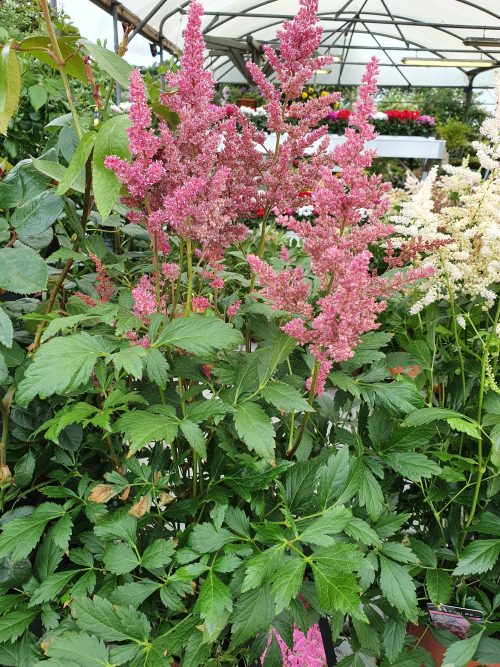
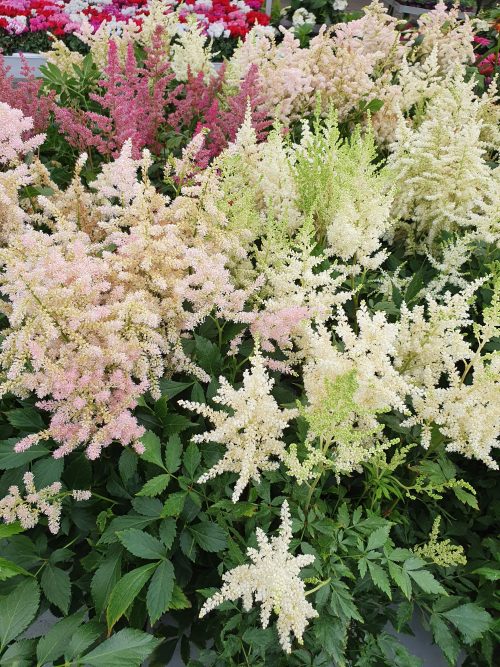
-
Out of stock
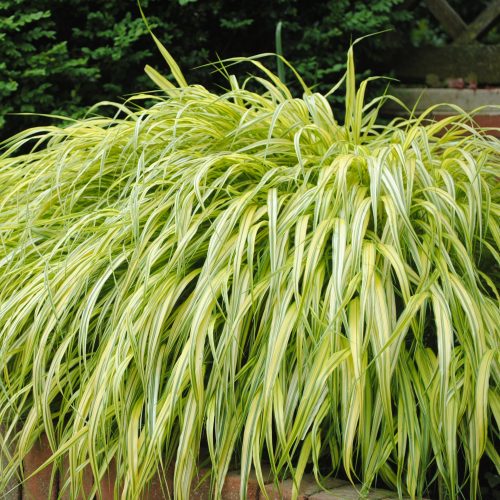
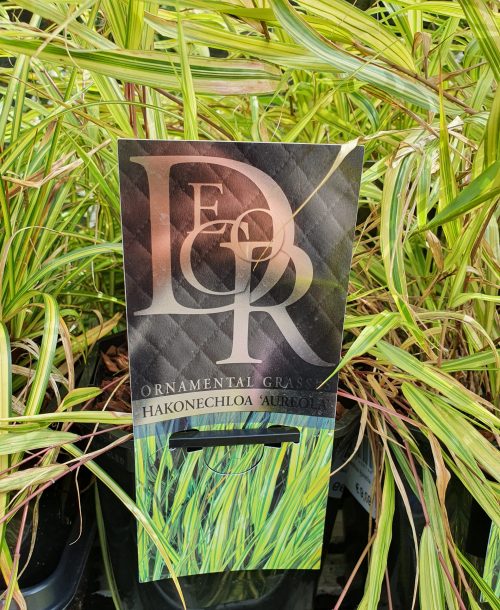 A cultivar of Japanese forest grass which makes a splash of colour in the garden, Hakonechloa macra Aureola is a clump-forming, deciduous, perennial grass which forms a broad, low, dense mound of narrow, arching, rather bamboo-like leaves. They are butter-yellow, striped with green, appear in early spring, keep their bright colour throughout the season, and are often tinged with coppery red in autumn. The colour is best in partial shade, turning shades of green in full shade. Tiny, insignificant, brown flowers appear in summer. Golden hakonechloa is tough, easy-to-grow and very hardy. It holds the RHS Award of Garden Merit. Site: Tolerates exposure Soil: Any moist but well-drained soil Position: Colours best in partial shade; tolerates full sun and full shade Season of interest: Spring to autumn Hardiness: Very hardy Height: 14”’ (35cm) Spread: 16” (40cm)
A cultivar of Japanese forest grass which makes a splash of colour in the garden, Hakonechloa macra Aureola is a clump-forming, deciduous, perennial grass which forms a broad, low, dense mound of narrow, arching, rather bamboo-like leaves. They are butter-yellow, striped with green, appear in early spring, keep their bright colour throughout the season, and are often tinged with coppery red in autumn. The colour is best in partial shade, turning shades of green in full shade. Tiny, insignificant, brown flowers appear in summer. Golden hakonechloa is tough, easy-to-grow and very hardy. It holds the RHS Award of Garden Merit. Site: Tolerates exposure Soil: Any moist but well-drained soil Position: Colours best in partial shade; tolerates full sun and full shade Season of interest: Spring to autumn Hardiness: Very hardy Height: 14”’ (35cm) Spread: 16” (40cm) -
Out of stock
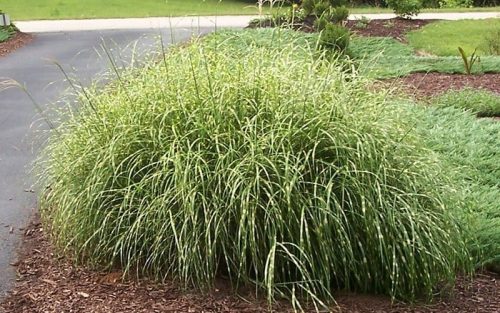
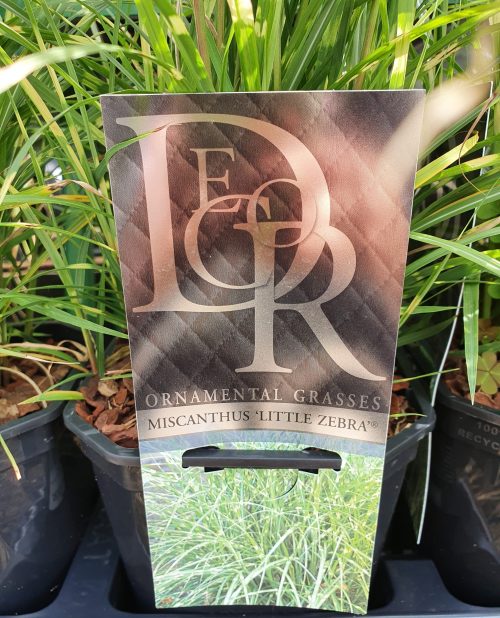 Little Zebra Grass features horizontal gold-and-green bands and a compact, mounding habit. In early fall, this spunky grass sends out attractive reddish, fan-shaped blooms that are held one foot above the foliage. The plumes change to a creamy tan color providing winter interest in the landscape. Because of its size and shape, Little Zebra Grass is the right proportion for small gardens, patios and decks. Its decorative leaves earn it a favored spot in large planters and urns. This sturdy dwarf Miscanthus holds its shape. Miscanthus sinensis ‘Little Zebra’ is unlikely to reseed because of its late-blooming characteristic. Foliage Type: Deciduous. Foliage: Green and Creamy-Yellow. Flower: Pale Pink to Silver. Flowering Period: Late-Summer. Suggested Location: Outdoor or Indoor. Suggested Soil Type: Well-Drained. Sand. Clay. Chalk. Loam. Suggested Exposure to Sunlight: Full Sunlight. Suggested Exposure to Weather: Exposed or Sheltered. Hardiness Rating: High Lowest Temperature Tolerance: -20 °C to -15 °C (-4 °F to 5 °F) Suggested Uses: Rock Gardens. Borders. Containers. Arrangements of Cut Flowers. Maintenance: Remove dead leaves and flowers in spring. Protect against excessive wet weather. Growth Habit: Bushy/Weeping. Growth Speed: Medium (30cm to 50cm per year) Starting Height: 30cm to 60cm (1.0 ft to 2.0 ft) Final Height: 100cm (3.2 ft) Starting Sideways Spread: 20cm to 40cm (0.7 ft to 1.3 ft) Final Sideways Spread: 100cm (3.2 ft)
Little Zebra Grass features horizontal gold-and-green bands and a compact, mounding habit. In early fall, this spunky grass sends out attractive reddish, fan-shaped blooms that are held one foot above the foliage. The plumes change to a creamy tan color providing winter interest in the landscape. Because of its size and shape, Little Zebra Grass is the right proportion for small gardens, patios and decks. Its decorative leaves earn it a favored spot in large planters and urns. This sturdy dwarf Miscanthus holds its shape. Miscanthus sinensis ‘Little Zebra’ is unlikely to reseed because of its late-blooming characteristic. Foliage Type: Deciduous. Foliage: Green and Creamy-Yellow. Flower: Pale Pink to Silver. Flowering Period: Late-Summer. Suggested Location: Outdoor or Indoor. Suggested Soil Type: Well-Drained. Sand. Clay. Chalk. Loam. Suggested Exposure to Sunlight: Full Sunlight. Suggested Exposure to Weather: Exposed or Sheltered. Hardiness Rating: High Lowest Temperature Tolerance: -20 °C to -15 °C (-4 °F to 5 °F) Suggested Uses: Rock Gardens. Borders. Containers. Arrangements of Cut Flowers. Maintenance: Remove dead leaves and flowers in spring. Protect against excessive wet weather. Growth Habit: Bushy/Weeping. Growth Speed: Medium (30cm to 50cm per year) Starting Height: 30cm to 60cm (1.0 ft to 2.0 ft) Final Height: 100cm (3.2 ft) Starting Sideways Spread: 20cm to 40cm (0.7 ft to 1.3 ft) Final Sideways Spread: 100cm (3.2 ft) -
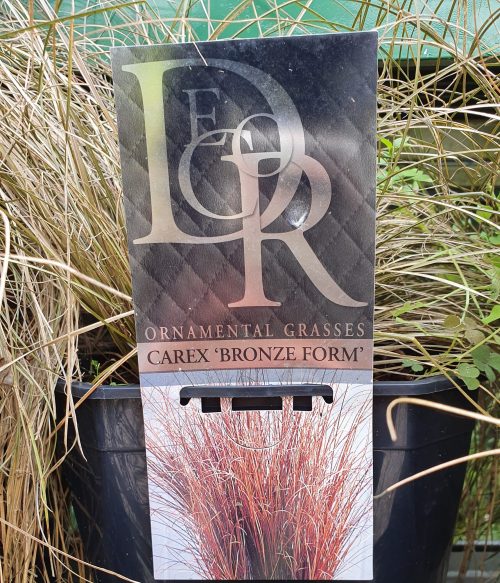
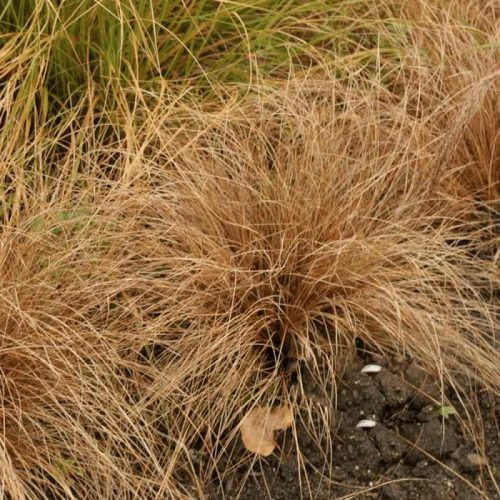 Water & Maintenance: Average watering required, low maintenance shrubs Growth & Spread: Height 0.5m - 1m, Spread 0.5m - 1m Flourishing Season: Flourishes all-round the year, flowers in June - July Characteristics: Evergreen shrubs, forms perfect architectural mound, narrow bronze leaves, tiny brown flowers, suitable for edging in rock garden
Water & Maintenance: Average watering required, low maintenance shrubs Growth & Spread: Height 0.5m - 1m, Spread 0.5m - 1m Flourishing Season: Flourishes all-round the year, flowers in June - July Characteristics: Evergreen shrubs, forms perfect architectural mound, narrow bronze leaves, tiny brown flowers, suitable for edging in rock garden -
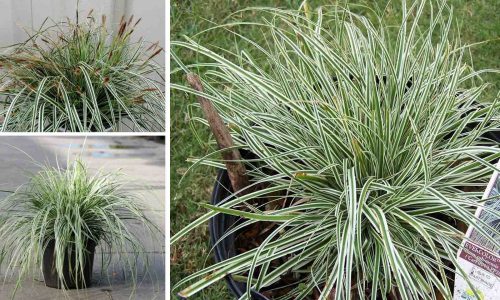
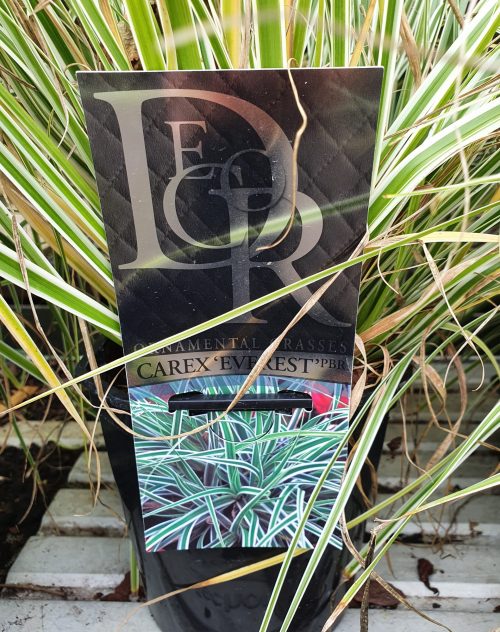 ‘Everest’ is a dense, tufted, evergreen, perennial grass forming a mound of narrow, arching, glossy, dark green leaves with white margins and lax stems bearing brown flower spikes in summer. 0.6m height x 0.6m spread 2-5 years until maturity
‘Everest’ is a dense, tufted, evergreen, perennial grass forming a mound of narrow, arching, glossy, dark green leaves with white margins and lax stems bearing brown flower spikes in summer. 0.6m height x 0.6m spread 2-5 years until maturity -
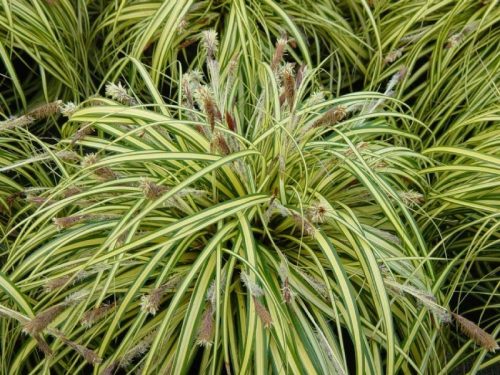
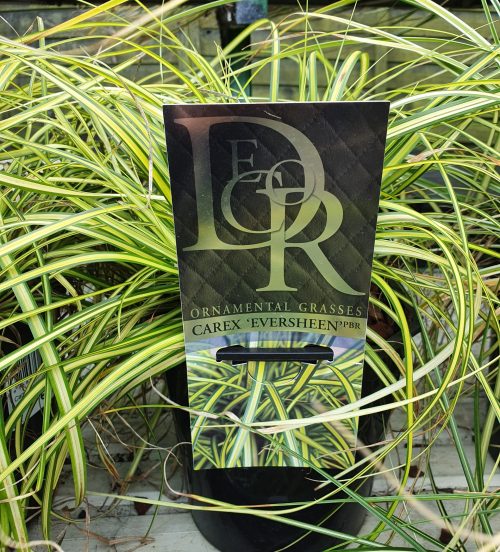 The citrus lemon-yellow blades edged in green add a refreshing zest even in the winter garden. Neat habit is perfect for container planting. Colorful year-round, the flowing arching mounds of Carex Eversheen is perfectly suited for shade, but can handle some sun in cooler climates. A pleasing addition to any spot as it bends and sways with the warm summer breezes. A nice edger. 0.4m height x 0.4m spread
The citrus lemon-yellow blades edged in green add a refreshing zest even in the winter garden. Neat habit is perfect for container planting. Colorful year-round, the flowing arching mounds of Carex Eversheen is perfectly suited for shade, but can handle some sun in cooler climates. A pleasing addition to any spot as it bends and sways with the warm summer breezes. A nice edger. 0.4m height x 0.4m spread